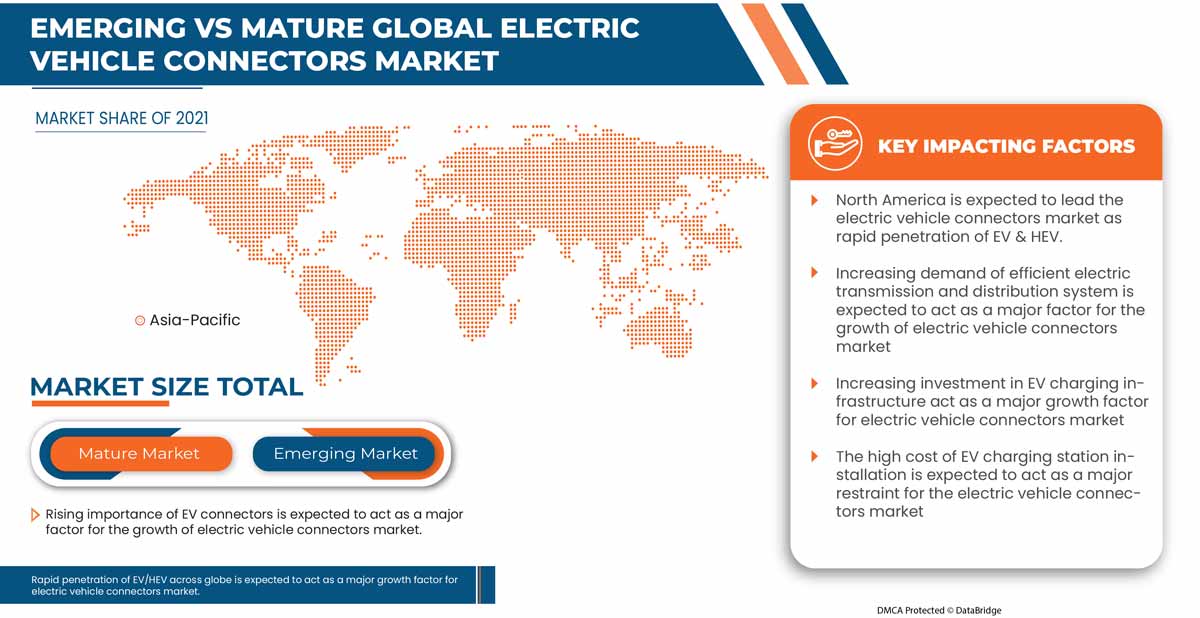Introduction
Electric vehicles (EVs) have rapidly transformed the global automotive landscape, bringing cleaner and more efficient transportation to the forefront. Central to this transformation are electric vehicle connectors, the essential interfaces that enable EVs to connect to charging stations and recharge their batteries. EV connectors come in various types and standards, each with unique specifications and applications, making them integral to the growth of the EV ecosystem.
As EV adoption continues to rise, understanding the types, standards, and functions of EV connectors is crucial for stakeholders across industries—from automakers and energy providers to consumers and policymakers. This blog dives into the complexities of EV connectors, exploring their design, functionality, industry standards, and the role they play in the sustainable future of transportation.
What Are Electric Vehicle Connectors?
Electric vehicle connectors are devices that enable EVs to connect to power sources for recharging. These connectors ensure that electrical power flows safely from the charging station to the EV battery. Available in multiple designs and specifications, EV connectors are classified by charging speeds (AC vs. DC), regional standards, and compatibility with different types of EVs.
The development of standardized EV connectors is essential for interoperability across different charging stations, ensuring that EV drivers have easy access to charging infrastructure regardless of their vehicle type.
Types of EV Connectors
EV connectors can be divided into three primary categories based on charging speed and power type:
1. Level 1 Connectors (AC Charging)
- Charging Speed: Slow
- Voltage: 120V (US) or 230V (Europe)
- Power Output: Up to 1.4 kW
Level 1 connectors provide basic AC charging, typically used in residential settings with standard household outlets. While slower compared to other connectors, Level 1 chargers are accessible and convenient for EV owners who charge their vehicles overnight. However, for rapid recharging needs, Level 1 connectors are less practical due to their low power output.
2. Level 2 Connectors (AC Charging)
- Charging Speed: Moderate
- Voltage: 240V (US) or 400V (Europe)
- Power Output: Up to 22 kW
Level 2 connectors are common in both residential and public charging setups, providing faster charging than Level 1. Widely compatible with various EV models, Level 2 chargers are frequently installed in homes, offices, and public spaces, balancing moderate charging speeds with accessibility.
3. DC Fast Charging Connectors
- Charging Speed: Rapid
- Voltage: 400V to 1000V
- Power Output: Up to 350 kW
DC fast charging connectors convert AC power to DC before it reaches the vehicle, significantly speeding up the charging process. These connectors are designed for commercial and highway locations, catering to EVs that need quick recharges during long-distance travel. However, not all EVs are compatible with DC fast charging, making it important to check vehicle specifications.
EV Connector Standards
EV connector standards vary by region, with distinct connectors in North America, Europe, and Asia. Each standard defines the specifications for connector design, voltage, current, and communication protocols, ensuring compatibility and safety.
1. SAE J1772 (Type 1)
- Location: North America, Japan
- Charging Type: AC Charging (Level 1 and Level 2)
The SAE J1772 connector is the standard in North America for Level 1 and Level 2 charging. It features a five-pin design that supports single-phase AC charging, suitable for both residential and public use. Widely compatible with many EV models, SAE J1772 ensures interoperability across charging stations in North America.
2. Type 2 (Mennekes)
- Location: Europe, Australia, and other regions
- Charging Type: AC Charging (Level 2 and higher)
The Type 2 connector, also known as the Mennekes connector, is the standard for AC charging in Europe. Supporting single- and three-phase AC charging, Type 2 connectors provide faster charging rates than SAE J1772. This connector’s design and performance capabilities make it ideal for both private and public charging in Europe.
3. CHAdeMO
- Location: Japan, North America, Europe
- Charging Type: DC Fast Charging
CHAdeMO is a DC fast charging connector developed in Japan and used globally for rapid EV charging. While CHAdeMO connectors are compatible with many EV models, they are gradually being replaced by other standards like CCS (Combined Charging System) in some regions due to limitations in maximum charging power.
4. Combined Charging System (CCS)
- Location: North America, Europe, other regions
- Charging Type: AC and DC Charging
CCS, also known as Combo, combines AC and DC capabilities into a single connector. This dual-purpose design makes CCS connectors versatile and widely adopted by various automakers. CCS is gaining popularity due to its high-power capacity and flexibility, becoming the standard in North America and Europe.
5. GB/T
- Location: China
- Charging Type: AC and DC Charging
China has developed its own standard, GB/T, which is used exclusively within the country. This connector type is split into separate connectors for AC and DC charging, providing high power outputs that support China’s vast and rapidly growing EV market.
Key Considerations in EV Connector Selection
When selecting an EV connector type, several factors play an important role:
1. Vehicle Compatibility
Different EV models support different connectors and charging levels. It’s essential to choose a connector compatible with the specific vehicle to ensure efficient charging.
2. Charging Speed Requirements
Depending on charging needs, organizations can select connectors that align with the required charging speed. Level 1 and Level 2 connectors work for slower, residential charging, while DC fast chargers are better suited for quick recharges in public locations.
3. Infrastructure and Location
Connector choice should consider the infrastructure setup. DC fast charging requires high-power setups, ideal for commercial and highway locations, while Level 1 or Level 2 charging can be installed in residential or low-traffic areas.
4. Future-Proofing
The EV industry is rapidly evolving, so selecting connectors compatible with upcoming technology, such as higher charging power capabilities and AI-enhanced charging, can ensure the infrastructure remains relevant over time.
Benefits of EV Connectors in Building EV Infrastructure
1. Enhanced Accessibility and Convenience
Standardized EV connectors increase accessibility to charging stations for all EV owners. With interoperable connectors, drivers can charge their vehicles across a range of charging networks, providing greater convenience.
2. Reduced Charging Times
Advanced connectors, such as CCS and CHAdeMO, support rapid DC charging, which shortens the time needed for a full charge. Reduced charging times make EVs more practical for long-distance travel and support the widespread adoption of electric vehicles.
3. Support for Renewable Energy
Some connectors support smart charging, allowing EVs to be charged during times of low electricity demand or when renewable energy sources are available. This feature reduces strain on the grid and supports sustainable energy practices.
4. Interoperability and Standardization
Interoperable connectors create a seamless experience for EV drivers, allowing them to use multiple charging networks with confidence. Standardization of connectors across regions enables manufacturers to develop globally compatible EV models.
Challenges and Solutions in EV Connector Implementation
While EV connectors provide essential benefits, implementing a cohesive EV connector ecosystem comes with challenges:
1. Connector Compatibility
The lack of universal compatibility among connector types can be challenging for drivers traveling across regions. Solutions such as adapters or universal charging stations help bridge this gap, though further standardization is required.
2. High Installation Costs
Setting up DC fast charging infrastructure with high-power connectors can be costly. Government incentives and partnerships between the public and private sectors can alleviate the financial burden, making high-speed charging more accessible.
3. Grid Infrastructure Limitations
As EV adoption grows, the increased demand for electricity at charging stations may strain the grid. Smart charging solutions, energy storage systems, and the use of renewables can help balance this demand and support grid stability.
4. Technological Obsolescence
As EV technology advances, connectors may become outdated. Ensuring new infrastructure is adaptable and forward-compatible with future EV technologies is essential for a sustainable EV network.
Future Trends in EV Connectors
1. Wireless Charging
Wireless EV charging is being developed to provide a seamless, connector-free charging experience. Inductive charging pads, embedded in the ground, could allow EVs to charge wirelessly, improving convenience and reducing wear on connectors.
2. Vehicle-to-Grid (V2G) Technology
V2G technology enables EVs to supply electricity back to the grid during peak hours. Future EV connectors will support bidirectional energy flow, making V2G technology more viable and helping balance grid demand.
3. Higher Power Outputs
Newer DC fast-charging connectors are being developed with power outputs exceeding 350 kW, further reducing charging times and making EVs more viable for long-distance travel.
4. AI-Enhanced Charging
AI and IoT can optimize charging times, manage power flow, and enhance energy efficiency. AI-enabled connectors will help align charging with grid demand and energy costs, providing smart, eco-friendly charging solutions.
Read Full Information: https://www.databridgemarketresearch.com/reports/global-ev-connectors-market
Conclusion
Electric vehicle connectors are the cornerstone of EV infrastructure, powering the shift towards sustainable transportation. By enabling faster, more efficient, and widespread charging, these connectors support the growth of EVs worldwide. As the EV market continues to evolve, connectors will play an increasingly vital role in shaping the future of mobility, driving technological advancements, and facilitating greener energy practices. For the industry, continued innovation in connector technology and infrastructure is essential for a seamless and scalable EV ecosystem.




